Galilean Relativity (DP IB Physics) : Revision Note
Newton's Postulates of Time & Space
We use inertial reference frames because Newton's laws of motion are the same in all of them
This is known as Galilean Relativity
For example, an object in an inertial reference frame will continue moving in a straight line with constant velocity unless acted upon by a force
This is in accordance with Newton's first law of motion
This means that the same laws of Physics apply, regardless of one's frame of reference relative to another, as long as they are moving in a straight line at a constant velocity
For an object moving with constant velocity in one reference frame, it will still have a constant (but different) velocity in another reference frame
The Cartesian coordinate system is generally used for reference frames
Cartesian co-ordinates in 3D and 2D diagram
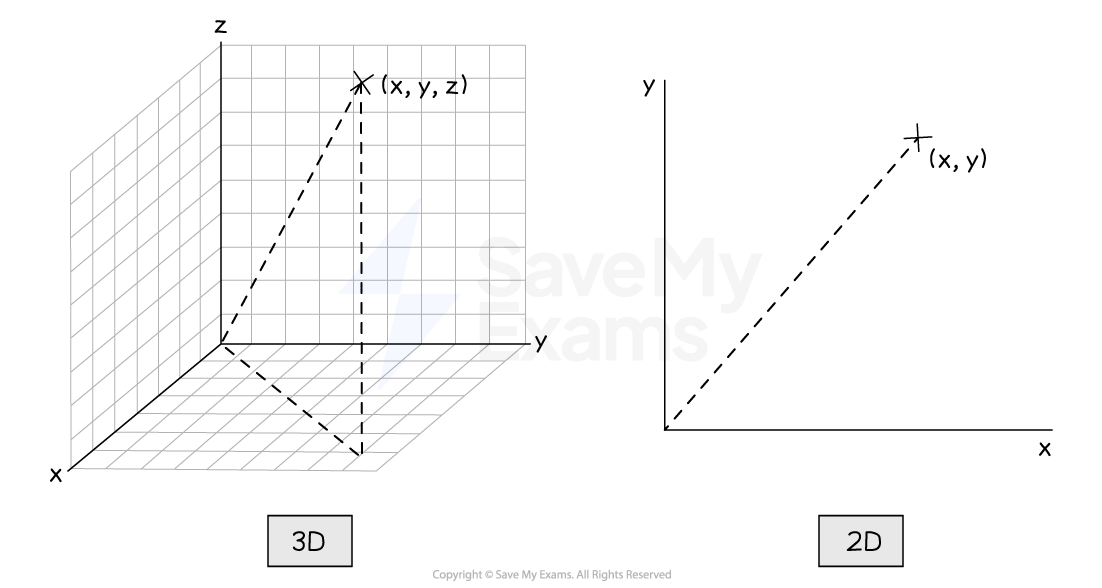
Cartesian coordinates are used to represent a point in space
Although there are an infinite number of inertial frames of reference in the Universe, there are ways to move between them
Examiner Tips and Tricks
Remember, anything that is moving in a curved line is accelerating. Therefore, you will not come across reference frames of something moving in a circle or an arc, but only straight lines with no acceleration.
Cartesian co-ordinates are technically used to refer to a point in 3D (x, y, z), although, your exam questions will focus on movement in 2D (x, y) as this is easier to draw diagrams for.
Galilean Relativity Equations
Galilean Transformation Equations
Galilean transformation equations are used to convert between coordinates of space and time in one frame of reference to another for an event
This is because the velocity, position and time of an event appear differently from different reference frames
For example, Person D is on a skateboard travelling at 4 m s–1 when they throw a ball in a straight line at a constant velocity of 2 m s–1. Person C is a stationary observer of the event.
In Person D's reference frame, the ball is travelling at 2 m s–1
In Person C's reference frame, the ball is travelling at 4 + 2 = 6 m s–1
So what is the speed of the ball? Well, it depends!
Diagram showing the difference in velocity of an object in two reference frames

Person C measures the ball to be travelling faster than when measured by Person D
Mathematically, the position and time of an event in one reference frame, S, is represented by the coordinates (x, y, t)
The position and time of an event in a second reference frame, moving relative to the first one, S', is represented by the co-ordinates (x', y', t')
Remember from the train example in Reference Frames, both Person A and Person B view the other as moving because they are viewing the event from two different frames of reference
Now consider another example:
Person C is stationary whilst Person D is moving away from Person C at velocity v
Both Person C and Person D witness a balloon pop at some distance away
Person D, in reference frame S', measures the balloon pop at a distance x' away
Person C, in reference frame S, measures the balloon pop at a distance x = x' + vt away
Diagram showing a stationary and moving reference frame
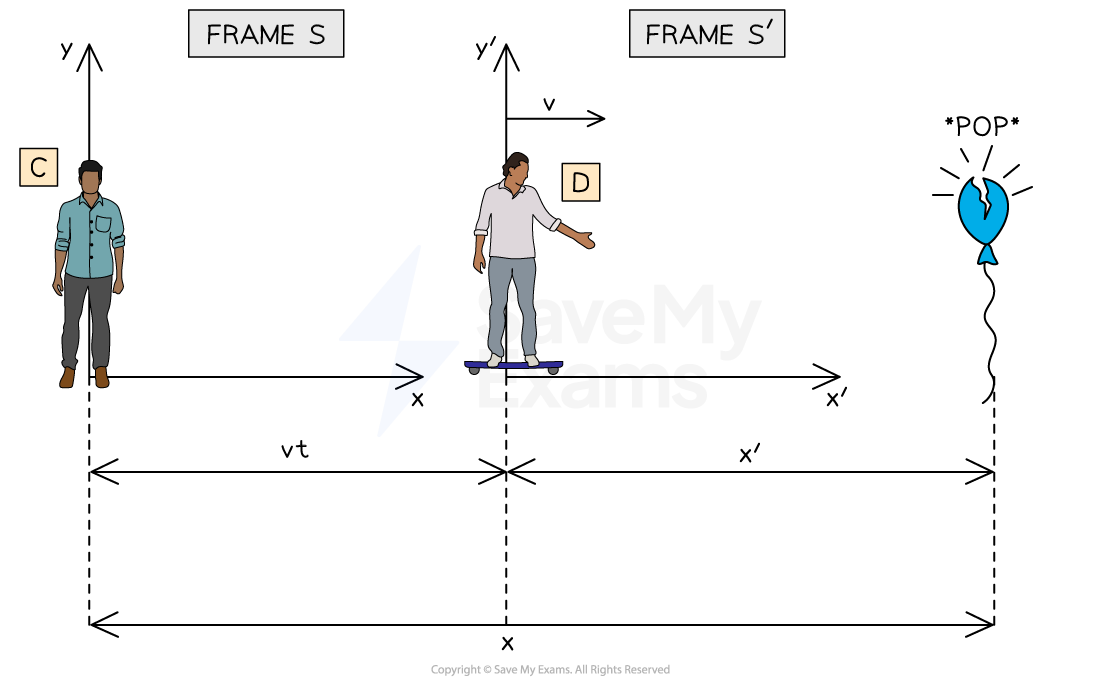
Person C and D measure the distance at which a balloon pops differently
Now let's see the event from Person D's frame of reference (S')
From Person D's point of view, they are stationary and it is Person C that is travelling away from them at speed v
Since this is the opposite direction to the v observed by Person C, Person C's velocity from Person D's perspective is -v
Therefore, Person D measures the balloon to pop at a distance x' = x - vt away
Remember the vt comes from distance (x) = speed (v) × time (t).
In both frames of reference, the time the balloon pops are still the same, hence t = t'
In summary:
Table of the Galilean relativity equations for a stationary and moving reference frame
Stationary reference frame | Moving reference frame | Transformation |
|---|---|---|
x | x' | x' = x – vt x = x' + vt |
y | y' | y = y' |
z | z' | z = z' |
t | t' | t = t' |
Co-ordinates y and z are also the same in both reference frames because the relative motion is only in the x direction
Worked Example
A train travels through a station at a constant velocity of 15 m s–1. One observer is sitting inside the train and another sits on the platform. As they pass each other, they start their stopwatches and watch a child on the train run at a constant speed in the same direction as the motion of the train. The observer on the train measures the speed of the child to be 2 m s–1.
(a) According to the observer on the train, how far has the child moved after 10 s?
(b) According to the observer on the platform, how far has the child moved after 10 s?
Answer:
Draw a quick sketch of the situation
Label the stationary (x, t) and moving (x', t') reference frames
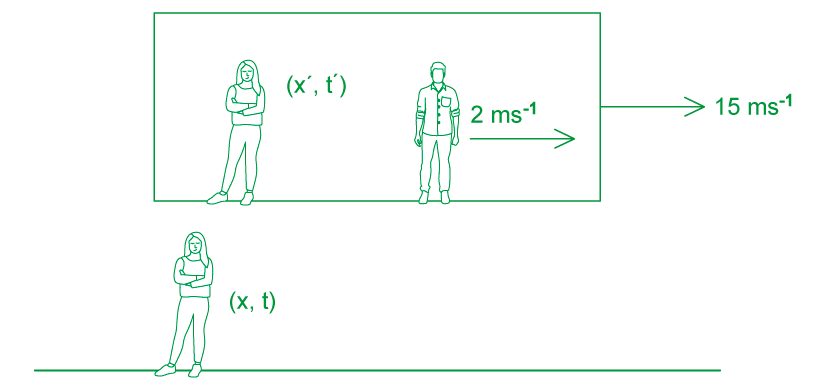
(a) Calculate the distance the child travels according to the observer on the train
The observer measures the child to be travelling away at 2 m s–1
Therefore, using the equation
distance (x) = speed × time
The distance, x' is:
x' = 2 × 10 = 20 m
(b) Calculate the distance the child travels according to the observer on the platform
This observer is stationary in their reference frame, so we use the equation
x = x' + vt
x = 20 + (15 × 10) = 170 m
v is the speed of the whole reference frame
Examiner Tips and Tricks
v is still a velocity and hence is a vector. Therefore, the direction matters i.e. a velocity in the opposite direction is -v.
Notice you only need to remember
is the same equation but rearranged for x' as the subject instead
You must be very careful about which observer you are referring to in any exam question.
In part (a) of the worked example, the child is running away from the observer on the train, because the observer on the train assumes that they are stationary
However, the observer on the platform witnesses the child running and the train moving too, so adds both of these velocities to get the total velocity of the child to be much higher
Velocity Addition Equation
Galilean transformations can also be used to transform velocities
This is known as velocity addition
Velocity addition is used when there are multiple velocities in the scenario
Let's go back to the example of Person D on a skateboard throwing a ball directly in front of them in a straight line
In this example:
u is the speed of the ball measured in frame S (by Person C)
u' is the speed of the ball measured in frame S' (by Person D)
v is the speed of Person D
Diagram showing velocity addition for two objects moving in the same direction
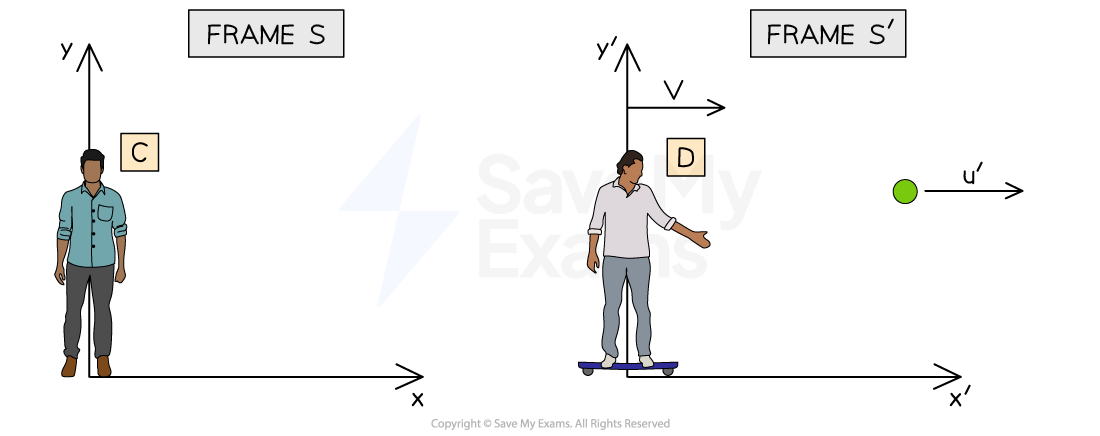
In Person C's reference frame, the ball is travelling at a speed of u' + v
Therefore:
Person D (frame S') measures the velocity of the ball to be u'
Whilst Person C (frame S) measures the velocity of the ball to be u = v + u'
Hence, the velocity of the ball from Person D's reference frame in terms of speeds v and u is
u′ = u – v
Velocities are vectors, so their direction must be taken into account
Let's say Person D now throws the ball directly behind them in a straight line at constant velocity
u, u' and v still refer to the same objects
This time, since u' is in the opposite direction to v, it is now –u'
Therefore:
Person D (frame S') measures the velocity of the ball to be –u'
Whilst Person C (frame S) measures the velocity of the ball to be u = v – u'
Diagram showing velocity addition for two objects moving in opposite directions
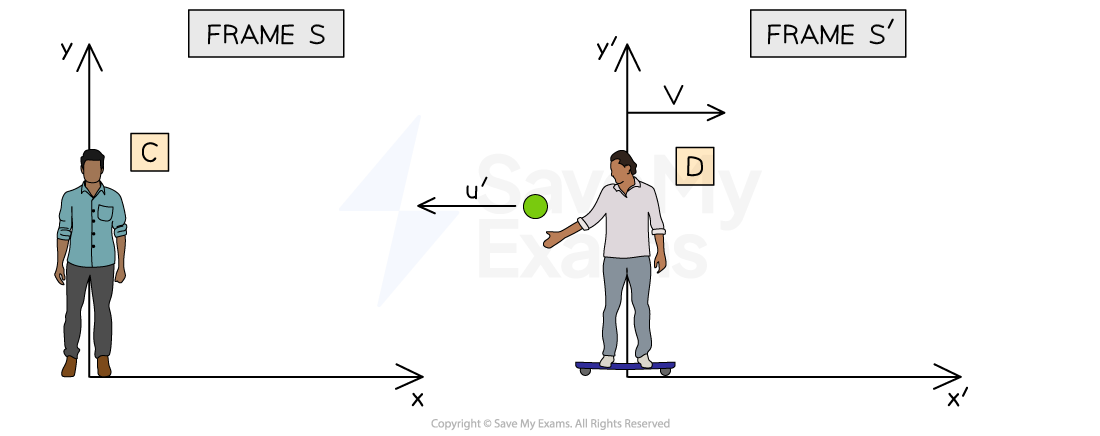
In Person C's reference frame, the ball is now travelling at a speed of v – u'
In summary:
Table of the velocity addition equations for a stationary and moving reference frame
Stationary reference frame | Moving reference frame | Transformation |
|---|---|---|
u | u' | u = u' + v u' = u − v |
Worked Example
Two travellers X and Y walk past each other at an airport. Traveller X walks at 1.5 m s–1 whilst Traveller Y walks at 2.1 m s–1.
Calculate the velocity of:
(a) Traveller Y relative to Traveller X
(b) Traveller X relative to Traveller Y
Traveller X now walks onto a travelator walkway in the airport at the same speed. The travelator moves at 0.3 m s–1. Traveller Y decides to take a seat facing the travelator.
Calculate the velocity of:
(c) Traveller X relative to Traveller Y when they are walking in the same direction as the travelator
(d) Traveller X relative to Traveller Y when they are walking in the opposite direction to the travelator (just for fun)
Answer:
(a) The velocity of Traveller Y relative to Traveller X is:
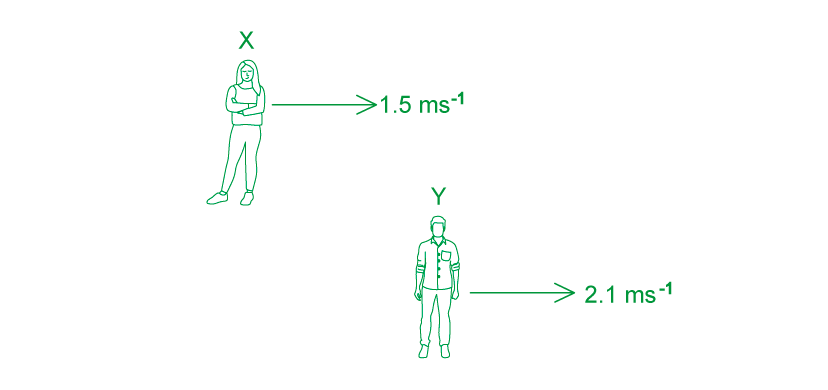
X is the reference frame at rest
Y is the reference frame that is moving
Therefore, from Traveller X's perspective, Traveller Y is moving at:
2.1 – 1.5 = 0.6 m s–1
From Traveller X's frame of reference, Traveller Y is moving at a speed of 0.6 m s–1
Traveller Y is moving faster than Traveller X by 0.6 m s–1
(b) The velocity of Traveller X relative to Traveller Y is:
Y is the reference frame at rest
X is the reference frame that is moving
Therefore, from Traveller Y's perspective, Traveller X is moving at:
1.5 – 2.1 = –0.6 m s–1
From Traveller Y's frame of reference, Traveller X is moving at a speed of −0.6 m s–1
Traveller X is moving slower than Traveller Y by 0.6 m s–1
(c) The velocity of Traveller X relative to Traveller Y when walking in the same direction as the travelator
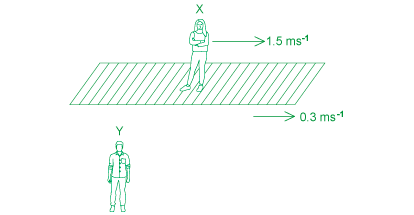
Y is the reference frame at rest
X is the reference frame that is moving with the travelator
u = velocity that Y measures X to be
u' = velocity of the travelator
v = velocity of X
Therefore, they are moving at:
u = u' + v = 0.3 + 1.5 = 1.8 m s–1
(d) The velocity of Traveller X relative to Traveller Y when walking in the opposite direction to the travelator
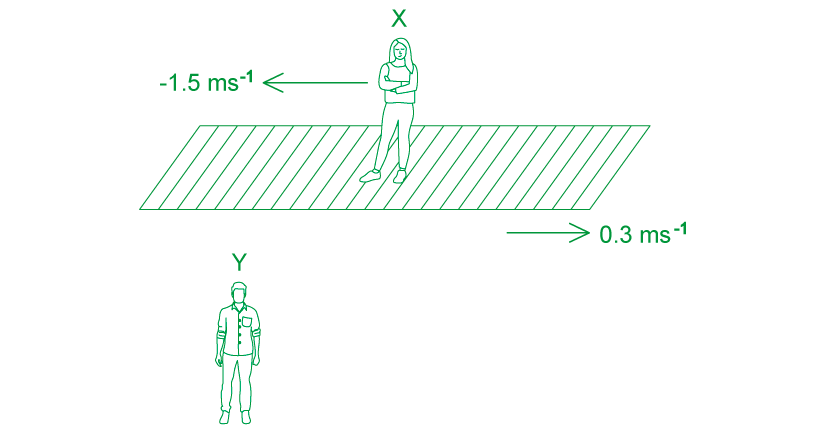
Y is the reference frame at rest
X is the reference frame that is moving against the travelator
u = velocity that Y measures X to be
u' = velocity of the travelator
–v = velocity of X
Therefore, they are moving at:
u = u' – v = 0.3 – 1.5 = –1.2 m s–1
Examiner Tips and Tricks
Always watch out for the direction of objects in velocity addition, don't just plug in numbers into the equation!
It helps to draw a quick sketch of the scenario in your exam and label the velocities. It doesn't matter which direction you take as positive, as long as you are consistent throughout your question.
Again, can be rearranged for
to give
i.e. the speed of the object in the other reference frame.

You've read 0 of your 5 free revision notes this week
Sign up now. It’s free!
Did this page help you?
